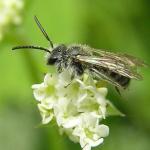This species was formerly known by the name Andrena saundersella (Perkins, 1914), now treated as a synonym of semilaevis Pérez.
The species occurs throughout much of the British Isles. In Britain it is found from the south coast of England north to the Isle of Man and northern Scotland (Easterness). It is similarly widespread in Ireland, reaching Down in the north. In the Channel Islands it has been reported from Alderney, Herm, Guernsey, Jersey (Richards, 1979) and Sark (Beavis, 2000). A common bee that is easily overlooked on account of its small size.
This is a northern and central European species, ranging from central Fennoscandia south to the Pyrenees, Yugoslavia and Ukraine (Gusenleitner & Schwarz, 2002). It is apparently absent from the Mediterranean Basin.
This species is not regarded as scarce or threatened.
Generally distributed, occurring for example in open woodland, grassland and coastal sites.
Usually credited as being univoltine, with a peak in numbers in late spring (May). However, there are many records of specimens being recorded during the summer (as late as August) so it is possible that in some locations the species is bivoltine, with a smaller summer brood.
Not known in detail. Stelfox (1927), when describing the habits of this bee in an Irish context, simply states that it nests in dry sunny slopes and banks. Kocourek (1966) reports that in eastern Europe the species nests solitarily in loamy soil.
The bee visits numerous flower species but is perhaps most closely associated with speedwell and umbellifers.
Nests are attacked by the cleptoparasite Nomada flavoguttata (Kirby) (Perkins, 1919; Kocourek, 1966). Some individuals are stylopised by Stylops spreta Perkins (Strepsiptera).
2016


